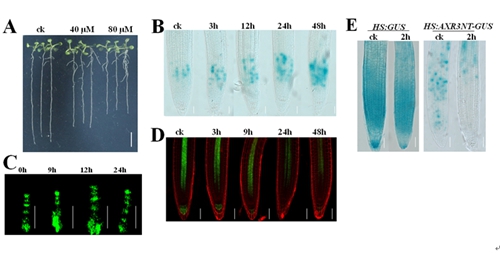Plant Physiol:中科院版纳植物园徐进研究组揭示MHPP通过生长素信号
近日,国际植物学顶级期刊《plant Physiology》杂志上在线发表了中国科学院西双版纳热带植物园热带植物资源可持续利用重点实验室,研究生刘阳阳为论文第一作者,徐进研究员为论文通讯作者。
MHPP(对羟基苯丙酸)是近年来发现的一种具有较强硝化抑制作用的植物根系分泌物,具有较大的农业生产应用潜力。除了作为生物硝化抑制剂, MHPP还可以调节植物根系的发育。外施MHPP可抑制主根的伸长,并显著诱导侧根的发生,同时提高了根系对营养元素的吸收。但其中的分子机制尚不清楚。
研究人员以拟南芥为材料,采用植物生理学、药理学、遗传学和分子生物学等研究手段,对MHPP调控植物根系发育的生理与分子机制进行了深入系统的研究。结果表明,外源MHPP影响了根尖分生区细胞的分裂势,因而抑制了主根伸长。深入研究发现,外源MHPP诱导了IAA合成相关基因的表达、改变了生长素转运蛋白的表达水平,同时促进了Aux/IAA蛋白的降解,因而改变了根尖生长素的分布和响应。此外,MHPP处理还诱导了根尖NO的累积及随后ROS水平的升高。进一步的研究证明,MHPP诱导的NO的累积及ROS水平的升高,影响了根尖生长素的感受和响应,因而抑制了根尖分生区细胞的分裂及主根生长。我们还发现,除了诱导IAA水平的升高,外源MHPP处理还显著诱导了根部JA和SA的升高,同时芥子油酸合成相关基因的表达明显上调。这些研究表明,MHPP除了作为一种生物硝化抑制剂,还可以通过生长素信号途径影响根系的发育;同时,还可能通过JA和SA信号途径诱导植物的抗病抗虫能力。这些研究揭示了MHPP的新功能,将为农业生产上使用这种生物硝化抑制剂提高氮肥利用效率、改良植物根系结构,提高根系对营养元素的吸收,以及提高植物的抗病抗虫性提供了理论依据。

MHPP通过生长素信号途径调控了植物根系可塑性发育
原文链接:
The nitrification inhibitor methyl 3-(4-hydroxyphenyl) propionate modulates root development by interfering with auxin signaling via the NO/ROS pathway
原文摘要:
Methyl 3-(4-hydroxyphenyl)propionate (MHPP) is a root exudate that functions as a nitrification inhibitor and as a modulator of the root system architecture (RSA) by inhibiting primary root (PR) elongation and promoting lateral root formation. However, the mechanism underlying MHPP-mediated modulation of the RSA remains unclear. Here, we report that MHPP inhibits PR elongation in Arabidopsis by elevating the levels of auxin expression and signaling. MHPP induces an increase in auxin levels by up-regulating auxin biosynthesis, altering the expression of auxin carriers, and promoting the degradation of the auxin/indole-3-acetic acid family of transcriptional repressors. We found that MHPP-induced nitric oxide (NO) production promoted reactive oxygen species (ROS) accumulation in root tips. Suppressing the accumulation of NO or ROS alleviated the inhibitory effect of MHPP on PR elongation by weakening auxin responses and perception and by affecting meristematic cell division potential. Genetic analysis supported the phenotype described above. Taken together, our results indicate that MHPP modulates RSA remodeling via the NO/ROS-mediated auxin response pathway in Arabidopsis. Our study also revealed that MHPP significantly induced the accumulation of glucosinolates in roots, implying the diverse functions of MHPP in modulating plant growth, development, and stress tolerance in plants.
作者:徐进

